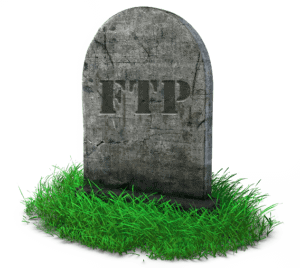Nearly all companies have the need to send and receive files, data and documents with external parties. Still, many companies utilize File Transfer Protocols (FTP) for the transmission of these files.
 FTP, File Transfer Protocol, has been around since the beginning of the internet, in the early 1970s. And just like the Walkman, Fax Machines and CD players, FTP have become outdated. It’s often cumbersome to use and security concerns have forced many businesses to seek out other options. Furthermore, FTP drains resources: from the time spent setting up users to the costs of hardware and ongoing maintenance. Even IT departments want an FTP alternative.
FTP, File Transfer Protocol, has been around since the beginning of the internet, in the early 1970s. And just like the Walkman, Fax Machines and CD players, FTP have become outdated. It’s often cumbersome to use and security concerns have forced many businesses to seek out other options. Furthermore, FTP drains resources: from the time spent setting up users to the costs of hardware and ongoing maintenance. Even IT departments want an FTP alternative.
Here are 3 reasons why FTP is a poor choice for transferring files:
1. FTP is Not Secure
FTP sends user names and passwords in plain text, so you’re opening yourself up to attack. If you are still using FTP to share files with your clients and partners, stop doing that and switch to something more secure. Read more.
2. FTP is Cumbersome
To send a file to a new contact, a new FTP account needs to be set up. Since users often do not have access to the FTP server and managing FTP is far from user friendly, they often need to rely on the help of an IT Administrator to create new accounts, retrieve forgotten passwords and remove accounts for those who no longer require access. This can result in users sharing accounts in order to avoid waiting for IT. Needless to say that this is less than desirable, from a security standpoint.
3. FTP lacks management tools
FTP does not allow senders to automatically expire or delete files. The files will sit on the FTP server until the IT Administrator deletes it. Since it is nearly impossible and a waste of valuable time for the IT Administrator to keep track of all the files on the FTP server, the files will generally remain there and be accessible for much longer than necessary.
So, why do companies still insist on setting up and making data available via FTP? Well, sometimes the company has been around for a while (like before Windows 3.1) and they may just have an antiquated system that they can’t (or won’t) update. But more often than not, it’s ignorance; the assumption that HTTP/HTTPS is used for the web, and FTP is used for downloads.
Sure, File-Transfer Protocol (FTP) used to be THE solution for sharing large digital files. It was a bit complex to use but it (eventually) did the job of getting your work to client or colleagues. Actually, for many people FTP became synonym with File Sharing and nothing could be more wrong. FTP was just a protocol used to transfer files when the internet was a safer, more trusting, place. That unfortunately, isn’t the case any more.
There is a better way
Most solutions today rely on HTTPS encryption instead of the insecure FTP protocol. HTTPS is intended to provide benefits like confidentiality, integrity and identity. Your information remains confidential from prying eyes because only your browser and the server are able to decrypt the traffic. Through this method of collaboration, you can conveniently and easily send and receive large files. Also, anyone with a web browser (and the proper credentials), gets to preview, download and upload files securely.
But that’s not all, when it comes to your company and your digital assets – it’s critical to use a professional file sharing program. Our solution, Filecamp, easily meets all those needs, with a SaaS file collaboration platform designed for professionals. Some of our clients such as HBO, the Wall Street Journal and Lego all use Filecamp’s technology to securely and conveniently collaborate with their colleagues and clients.
There are many reasons why companies are making the switch to Filecamp, and here are just a few customer testimonials:
- “It is a simple and straightforward system that’s easy to use for all employees”
- “Budget-friendly”
- “Recommended by graphic designers”
- “No training needed”
How important is your data asset management to you? Are your employees sharing confidential company information via their personal Dropbox and/or Skydrive accounts? Are you looking for a solution to support the latest browsers? With Filecamp, you can do all of the above, and it offers:
- Custom branding
- Image bank features
- Web-based access
- Metadata/keywords
- Direct File/Folder links
- Advanced download options
- File previews
- Access control
- Online commenting
- Version control
Your digital assets does not need to end up in the wrong hands. Moreover, you should have the ability to access your information from anywhere at any time. So, what are you waiting for? Start a free Filecamp trial today.
Share this Post
